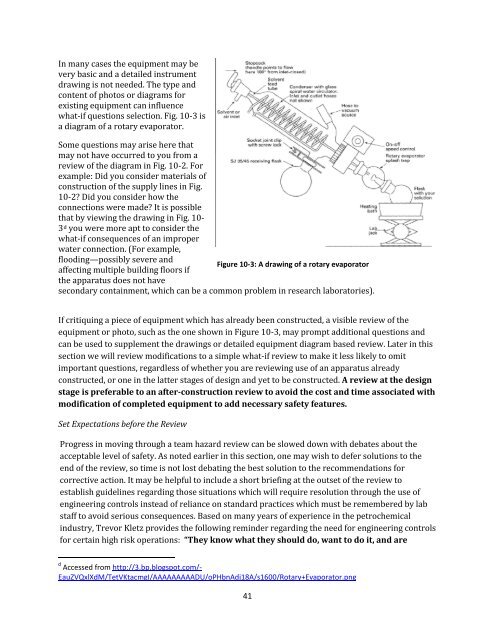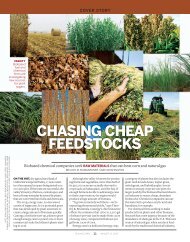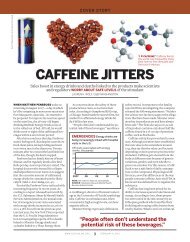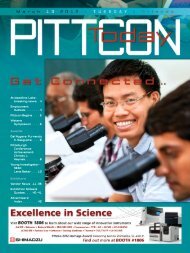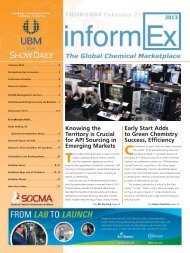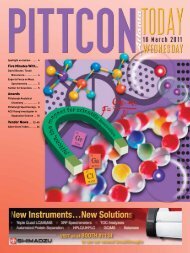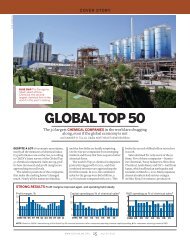Identifying and Evaluating Hazards in Research Laboratories
Identifying and Evaluating Hazards in Research Laboratories
Identifying and Evaluating Hazards in Research Laboratories
Create successful ePaper yourself
Turn your PDF publications into a flip-book with our unique Google optimized e-Paper software.
In many cases the equipment may bevery basic <strong>and</strong> a detailed <strong>in</strong>strumentdraw<strong>in</strong>g is not needed. The type <strong>and</strong>content of photos or diagrams forexist<strong>in</strong>g equipment can <strong>in</strong>fluencewhat-if questions selection. Fig. 10-3 isa diagram of a rotary evaporator.Some questions may arise here thatmay not have occurred to you from areview of the diagram <strong>in</strong> Fig. 10-2. Forexample: Did you consider materials ofconstruction of the supply l<strong>in</strong>es <strong>in</strong> Fig.10-2? Did you consider how theconnections were made? It is possiblethat by view<strong>in</strong>g the draw<strong>in</strong>g <strong>in</strong> Fig. 10-3 d you were more apt to consider thewhat-if consequences of an improperwater connection. (For example,flood<strong>in</strong>g—possibly severe <strong>and</strong>Figure 10-3: A draw<strong>in</strong>g of a rotary evaporatoraffect<strong>in</strong>g multiple build<strong>in</strong>g floors ifthe apparatus does not havesecondary conta<strong>in</strong>ment, which can be a common problem <strong>in</strong> research laboratories).If critiqu<strong>in</strong>g a piece of equipment which has already been constructed, a visible review of theequipment or photo, such as the one shown <strong>in</strong> Figure 10-3, may prompt additional questions <strong>and</strong>can be used to supplement the draw<strong>in</strong>gs or detailed equipment diagram based review. Later <strong>in</strong> thissection we will review modifications to a simple what-if review to make it less likely to omitimportant questions, regardless of whether you are review<strong>in</strong>g use of an apparatus alreadyconstructed, or one <strong>in</strong> the latter stages of design <strong>and</strong> yet to be constructed. A review at the designstage is preferable to an after-construction review to avoid the cost <strong>and</strong> time associated withmodification of completed equipment to add necessary safety features.Set Expectations before the ReviewProgress <strong>in</strong> mov<strong>in</strong>g through a team hazard review can be slowed down with debates about theacceptable level of safety. As noted earlier <strong>in</strong> this section, one may wish to defer solutions to theend of the review, so time is not lost debat<strong>in</strong>g the best solution to the recommendations forcorrective action. It may be helpful to <strong>in</strong>clude a short brief<strong>in</strong>g at the outset of the review toestablish guidel<strong>in</strong>es regard<strong>in</strong>g those situations which will require resolution through the use ofeng<strong>in</strong>eer<strong>in</strong>g controls <strong>in</strong>stead of reliance on st<strong>and</strong>ard practices which must be remembered by labstaff to avoid serious consequences. Based on many years of experience <strong>in</strong> the petrochemical<strong>in</strong>dustry, Trevor Kletz provides the follow<strong>in</strong>g rem<strong>in</strong>der regard<strong>in</strong>g the need for eng<strong>in</strong>eer<strong>in</strong>g controlsfor certa<strong>in</strong> high risk operations: “They know what they should do, want to do it, <strong>and</strong> ared Accessed from http://3.bp.blogspot.com/-EauZVQxlXdM/TetVKtacmgI/AAAAAAAAADU/oPHbnAdj18A/s1600/Rotary+Evaporator.png41


